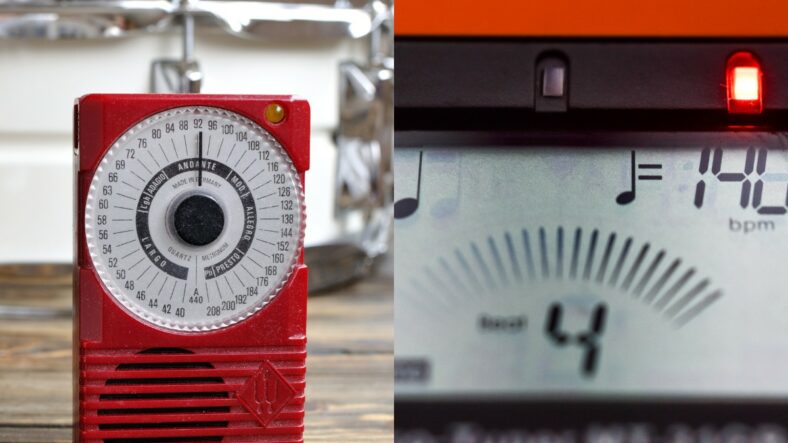10 Songs With Tempo Changes

The use of tempo changes in songs requires a level of skill and expertise that can only be attained through practice and understanding. The ability to master tempo changes demonstrates an artist’s creative range and gives their music an additional level of depth and expression. From crafting captivating solos to connecting emotion with rhythm, the possibilities are endless.
So today, we will be diving deep into the tempo changes demonstrating the great importance of tempo changes in various songs, from Lynyrd Skynyrd’s “Freebird” to Radiohead’s “Paranoid Android.” While every artist utilizes tempo changes in their own distinct way, the fact remains that it is an invaluable tool in defining the musical language of a track.
So, the next time you listen to a song, don’t forget to pay attention to the subtle shifts in the tempo and appreciate the artistry that goes into creating a music experience that engages listeners deeply.
Contents
- 1. Lynyrd Skynard – Freebird
- 2. Isley Brothers – Shout
- 3. Queen – Bohemian Rhapsody
- 4. System Of A Down – Toxicity
- 5. Led Zeppelin – Stairway To Heaven
- 6. Franz Ferdinand – Take Me Out
- 7. Billy Joel – Scenes from an Italian Restaurant
- 8. The Weeknd – Save Your Tears
- 9. Radiohead – Paranoid Android
- 10. Santana – Black Magic Woman
- How Tempo Changes Affect The Vibe of a Song
- Conclusion
1. Lynyrd Skynard – Freebird
Lynyrd Skynyrd’s iconic rock ballad, “Free Bird,” stands as a testament to the band’s musical prowess and emotional depth. Released in 1973 as a part of their debut album “Pronounced ‘Lĕh-‘nérd ‘Skin-‘nérd,” the song is renowned for its epic guitar solos, heartfelt lyrics, and dynamic tempo shifts.
“Free Bird” is a journey that encapsulates both the yearning for freedom and the bittersweet beauty of life’s fleeting moments. The song’s melancholic verses, backed by a steady rhythm, paint a picture of introspection and self-discovery. However, it’s the transformation that occurs during the instrumental break that truly captivates listeners.
As the song transitions from the verses into the extended guitar solo, the tempo undergoes a remarkable change. What initially begins as a reflective and somber atmosphere gradually morphs into a whirlwind of energy and virtuosity. The guitar solo section, famously known for its dual-guitar harmonies and passionate performance, starts off modestly before gradually building in intensity.
This ascent is marked by an increase in tempo and a surge in emotional fervor. The guitarists engage in a musical dialogue, their instruments seemingly engaging in a conversation that resonates deeply with the audience. This climactic moment serves as a cathartic release, an explosion of emotion that encapsulates the song’s themes of liberation and transcendence. The seamless yet dramatic tempo change in “Free Bird” not only showcases the band’s technical prowess but also mirrors the highs and lows of life itself, making it an enduring classic in the rock canon.
2. Isley Brothers – Shout
The Isley Brothers’ timeless hit “Shout” is a high-energy R&B and rock ‘n’ roll anthem that has become synonymous with exuberant celebration and joyous dance floors. Originally released in 1959, the song’s electrifying tempo changes play a pivotal role in its enduring popularity.
“Shout” starts off with a moderate pace, driven by a pulsating rhythm and the soulful lead vocals of Ronald Isley. The initial verses and chorus set the stage, inviting listeners to join in and groove along. The song’s infectious energy steadily builds, with the Isley Brothers’ tight vocal harmonies and the rhythm section’s infectious groove creating an irresistible backdrop.
However, it’s during the instrumental break that “Shout” takes a dynamic turn that elevates its excitement to a whole new level. As the tempo ramps up, the song transforms into a whirlwind of fervent shouts, call-and-response interactions, and exuberant vocal deliveries. This section is where the Isley Brothers’ vocal prowess truly shines, as they unleash a series of passionate wails and improvised vocal acrobatics that encourage listeners to participate in the cathartic musical experience.
The tempo change propels the song into an ecstatic climax, culminating in a crescendo of harmonious voices and rhythmic intensity. The ingenious use of tempo shifts in “Shout” showcases the Isley Brothers’ ability to create a sonic rollercoaster, ensuring that the song remains an enduring party anthem that continues to compel people of all generations to hit the dance floor with unbridled enthusiasm.
3. Queen – Bohemian Rhapsody
“Bohemian Rhapsody,” an iconic rock masterpiece by the legendary band Queen, is a genre-defying musical journey that continues to captivate audiences with its eclectic blend of rock, opera, and ballad elements. Released in 1975 as part of their album “A Night at the Opera,” the song’s unique structure and dramatic storytelling have solidified its place in music history.
Spanning six minutes, the track defies traditional song structures, seamlessly weaving together introspective verses, operatic choruses, and guitar-driven rock segments. At its core, “Bohemian Rhapsody” follows the protagonist’s emotional turmoil, inviting listeners into a whirlwind of emotions ranging from introspection to defiance.
One of the most striking features of “Bohemian Rhapsody” is its dynamic use of tempo changes. The song begins with a slow, haunting ballad that sets a melancholic tone as Freddie Mercury’s vocals draw listeners into the protagonist’s world. As the narrative unfolds, the tempo quickens during the operatic section, transitioning into a high-energy rock segment marked by Brian May’s electrifying guitar work.
This transition brings a surge of energy and serves as a contrast to the introspective moments, culminating in a climactic and anthemic conclusion. The tempo changes in “Bohemian Rhapsody” are not only a testament to Queen’s musical versatility but also a reflection of the emotional rollercoaster the song’s storyline portrays, making it a timeless and unforgettable musical masterpiece.
4. System Of A Down – Toxicity
“Toxicity” by System of a Down is a powerful and thought-provoking song that encapsulates the band’s unique blend of alternative metal, hard rock, and socio-political commentary. Released in 2001 as the title track of their album, the song’s intricate arrangement and intense vocal delivery make it a standout in the band’s discography.
The lyrics touch on themes of societal issues and self-awareness, reflecting the band’s signature ability to combine heavy music with poignant messages. The opening of “Toxicity” immediately draws listeners in with its captivating melody and Serj Tankian’s distinctive vocal style. As the song progresses, the tempo builds, and the instrumentation intensifies, creating a sense of mounting tension that mirrors the song’s thematic content.
Around the 2:40 mark, “Toxicity” undergoes a remarkable tempo change that serves as a climactic turning point in the track. The song’s tempo accelerates, and the band launches into a furious and frenetic passage characterized by aggressive guitar riffs, thunderous drums, and Tankian’s impassioned vocals.
This transition adds an extra layer of intensity to the song, reflecting the emotional turmoil and urgency present in the lyrics. The tempo change showcases System of a Down’s ability to seamlessly shift gears within their music, creating a dynamic listening experience that engages the audience both emotionally and sonically. This moment in “Toxicity” not only demonstrates the band’s technical prowess but also adds to the overall impact of the song, solidifying its status as a standout in the world of modern rock.
5. Led Zeppelin – Stairway To Heaven
“Stairway to Heaven” by Led Zeppelin stands as one of the most iconic and revered rock songs in history, known for its intricate composition and emotional depth. The song, released in 1971 on the band’s untitled fourth album, seamlessly weaves together folk-inspired acoustic passages with powerful rock dynamics.
An analysis by Aaron Krerowicz highlights the fascinating tempo changes within the track, subtly almost in every section. The song begins with a gentle, contemplative acoustic guitar introduction that establishes a serene atmosphere. As Robert Plant’s vocals enter, the tempo remains steady, inviting listeners into a reflective narrative.
Around the four-minute mark, “Stairway to Heaven” experiences a significant tempo shift that ushers in a dynamic transformation. The song transitions from its initial mellow pace to a more energetic and anthemic rock section featuring Jimmy Page’s electrifying guitar solo and John Bonham’s driving drums.
This change in tempo and intensity marks a pivotal moment in the song, propelling it into a powerful crescendo that showcases Led Zeppelin’s ability to seamlessly navigate through various musical moods. The tempo change not only adds a thrilling dimension to the track but also mirrors the emotional journey depicted in the lyrics, making “Stairway to Heaven” a timeless masterpiece celebrated for its intricate composition and evocative storytelling.
6. Franz Ferdinand – Take Me Out
“Take Me Out” by Franz Ferdinand is a standout indie rock anthem that burst onto the scene in 2004, leaving an indelible mark on the music landscape. The song’s infectious energy, catchy riffs, and danceable rhythm make it an instant crowd-pleaser.
One of the most notable features of “Take Me Out” is the dynamic tempo change that occurs within the track. The song begins with a driving and rhythmic guitar riff that establishes an upbeat and captivating groove. As lead singer Alex Kapranos delivers the lyrics with a distinctive vocal style, the tempo remains steady, driving the song forward with an irresistible momentum.
Around the one-minute mark, “Take Me Out” takes an unexpected turn with a sudden drop in tempo that leads to a tense and atmospheric interlude. This shift adds a layer of complexity to the song, creating a brief moment of anticipation before the track explodes back into its high-energy chorus.
The tempo change effectively highlights the band’s knack for crafting a captivating musical journey that keeps listeners engaged and surprised. This unique structural choice showcases Franz Ferdinand’s innovative approach to songwriting, and it’s a pivotal element that contributes to the enduring popularity and impact of “Take Me Out” within the indie rock genre.
7. Billy Joel – Scenes from an Italian Restaurant
“Scenes from an Italian Restaurant” by Billy Joel is a masterful musical narrative that takes listeners on an evocative journey through different moods and settings. Released in 1977 as part of the album “The Stranger,” the song is a quintessential example of Joel’s storytelling prowess and songwriting versatility.
The track is divided into distinct sections, each with its own mood and tempo. It begins with a melodic and reflective piano introduction, setting a nostalgic tone that draws listeners into the narrative. As Joel’s vocals begin to paint a vivid picture of the characters and their interactions, the tempo remains measured and contemplative, capturing the essence of the scene being described.
“Scenes from an Italian Restaurant” undergoes significant tempo changes alongside the sections of the narrative perfectly. The song shifts from its initial ballad-like quality to an energetic and jazzy groove, accompanied by spirited piano playing and dynamic instrumentation.
This change in tempo adds a burst of energy and contrasts with the introspective moments that precede it, creating a sense of musical and emotional variety. The tempo change showcases Joel’s ability to navigate through different musical styles within a single composition, enhancing the depth and complexity of the song’s narrative. “Scenes from an Italian Restaurant” stands as a testament to Billy Joel’s songwriting prowess, demonstrating his talent for crafting a rich and immersive musical experience that resonates with listeners on multiple levels.
8. The Weeknd – Save Your Tears
“The Weeknd’s “Save Your Tears” is a compelling pop hit that showcases the artist’s signature blend of emotive vocals and modern production. Released in 2020 as part of his album “After Hours,” the song delves into themes of heartache and yearning, marked by its catchy melody and atmospheric soundscapes.
Notably, the tempo change between the verses and the chorus serves as a key element that adds to the song’s emotional impact. The verses of “Save Your Tears” maintain a mid-tempo pace, allowing The Weeknd’s smooth vocals to take center stage as he sings about a failed relationship and the pain of deception. This initial tempo choice creates a sense of introspection and vulnerability, drawing listeners into the emotional core of the song.
However, as the song transitions into the chorus, there’s a noticeable uptick in tempo that infuses the track with a burst of energy. The beat becomes more pronounced, and the instrumentation gains momentum, elevating the emotional intensity of the lyrics.
This shift in tempo effectively mirrors the emotional turmoil conveyed in the song, as The Weeknd’s voice soars amidst the more dynamic arrangement, creating a memorable contrast between the melancholic verses and the anthemic chorus. The tempo change in “Save Your Tears” is a testament to The Weeknd’s ability to manipulate musical elements to evoke a range of emotions, making the song a standout in his discography and a hit that resonates with a wide audience.
9. Radiohead – Paranoid Android
One of the most popular and greatest songs of Radiohead is Paranoid Android, with its great cymbal swells, pauses, and frequent tempo changes. Radiohead created an amazing song, maintaining the feel of the track while changing the audioscape frequently.
The song starts with some arpeggios with a moderate tempo before going to a more aggressive, high-tempo, rocky feel. While the song transits between those two different sections, you feel it is coming to an end, but it shifts to another section with a much slower tempo and a mild feel before going to the outro with the high-tempo rocky feel again with a great guitar solo.
The song switches gears beautifully throughout the track and surprises you with its unexpected shifts. It is an amazing song with an experimental feel.
10. Santana – Black Magic Woman
“Black Magic Woman” by Carlos Santana is an infectious track with a memorable bossa nova style rhythm. Santana’s iconic guitar playing is highlighted in the intro, and sets the tone for the first verse and chorus before the track goes into a different realm with the solo part, where the tempo change happens.
The faster paced, jam-section allows Santana to showcase his signature guitar chops, riffs and solos. The bass especially takes center-stage in this section and sets the foundation for Santana’s guitar playing. With soulful licks and vamps, this section builds up tension and culminates in a climactic ending. It’s an immensely enjoyable track that showcases Santana’s unique style.
How Tempo Changes Affect The Vibe of a Song
Tempo changes can significantly shape the depth, expression, and narrative power of a track, creating a musical experience that resonates with listeners.
- Tempo changes significantly influence the emotional tones and expressions within a song, making the output more nuanced.
- With rhythm shifts, artists can dictate the energy flow of their creations, lending more power to their musical narrations.
- Importantly, tempo changes help create mood swings within a song, giving the audience a more immersive and engaging musical experience.
Conclusion
Tempo changes are an invaluable technique for artists to master, as they help them craft captivating musical pieces with a great level of depth and expression. Through skillful use of tempo changes, artists can effectively control the flow and energy of the songs and create a more immersive and engaging musical experience for their audience. It is a powerful tool for dictating the dynamics of songs and transforming them into a unique and captivating musical narrative.





